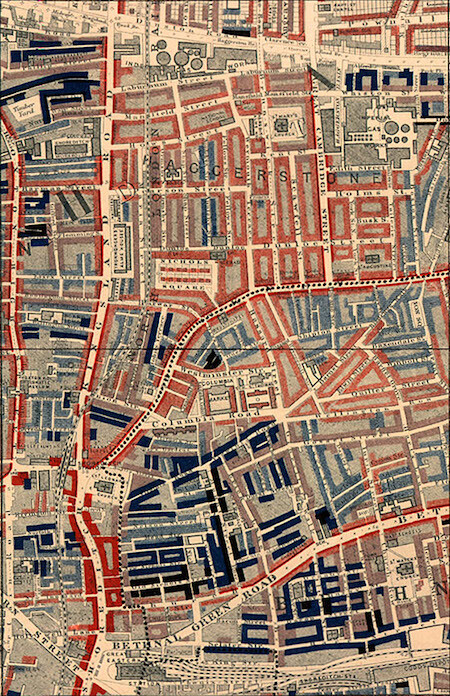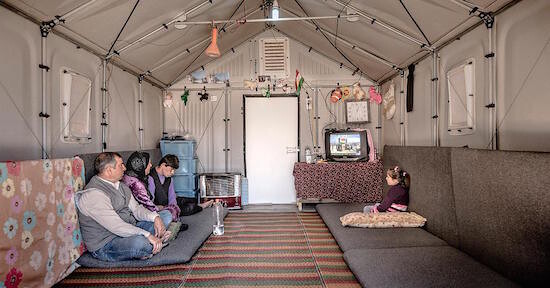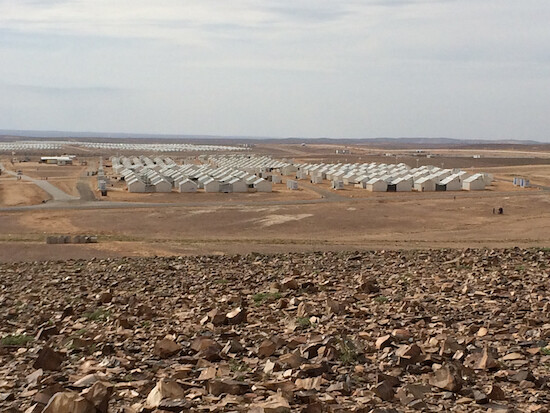“Digital Food,” “Digital Shelter,” and Voucher Humanitarianism
Some refugees from the current civil war in Syria have fled to Lebanon, Jordan, and Turkey and found themselves in novel spaces—novel not only with respect to the spaces they fled from, but also with respect to the spaces occupied by previous generations of refugees. These new spaces of refuge are structured by technologies of credit distribution in the form of automated teller machines and credit card readers: the means by which the United Nations High Commissioner for Refugees (UNHCR) and the World Food Program (WFP) have been providing assistance to Syrian refugees with which to purchase food and rent shelter.1 This “voucher humanitarianism,” undertaken in partnership with credit card companies, mobile phone companies, banks, and other businesses, has already yielded what MasterCard and the WFP call “digital food,” as well as a form of housing relief that, replacing the refugee camp, will doubtlessly soon invoke the term “digital shelter.”2
In one of the most recent innovations in voucher humanitarianism, all Syrian refugees arriving in Jordan are added to a biometric database. At Jordanian ATMs equipped with iris scanners, these refugees can be identified by iris scans rather than by ATM cards and PIN codes:
Instead of receiving food packages, money vouchers or bank cards from the UNHCR, refugees in the iris-identification system receive a monthly text message saying money has been placed in their accounts. Then, they walk up to an ATM owned by Cairo Amman Bank, and, rather than insert a card and punch in a pass code, they look into a specially designed iris camera. Once ID’d, a refugee would be able to withdraw his or her monthly allotment of cash.3
Two rationales have been offered for iris scanning, each based on the increased efficiency of aid distribution that this scanning presumably permits: while refugees can “access their money in a secure way without having to keep track of a card and number,” scanning will also “help thwart refugee fraud.”4 And yet, voucher humanitarianism has also brought about a new relationship between humanitarianism and the housing market. With the control of refugee bodies no longer predicated on the spatial boundaries of the refugee camp, the development of a system of housing vouchers for refugees allows the housing market to at least notionally accommodate the provision of shelter even in states of humanitarian emergency. From substandard working class housing in industrializing cities of nineteenth-century England to the neighborhoods of foreclosed middle class housing in post-2008 US cities, the capitalist housing market has repeatedly been posed as a crisis or emergency, structurally unable to provide adequate levels of affordable housing; now, with the advent of “digital shelter,” precisely the same housing market is being posed as a response to housing crises and emergencies.


It is revealing, then, to examine voucher humanitarianism not only in the context of the new technologies that enable it—by far the predominant way in which it has been investigated—but also in the context of humanitarian history. In a recent essay, Daniel Bertrand Monk and I have argued that humanitarianism and architecture have shared, for much of their modern histories, a preoccupation with housing and, specifically, the question of how to house those living in particularly precarious circumstances.5 In terms of this history, the refugee camp might represent one of the last places where the interests of humanitarianism and architecture have intersected; with the emergence of “digital shelter,” the refugee camp is in effect privatized, its functions distributed across city-as-such, no matter its condition. Normalizing precarity, this rendering disposes of the housing question as a provocation to envision other forms of housing, if not other ways of living in common. When housing questions are answered by the existing housing market, in other words, the market’s structural inadequacies and inequities are assumed and reproduced; to think about adequate housing for the displaced and impoverished is to problematize the conditions and situations that displace and impoverish vulnerable communities and to invite imagination of different conditions and new situations in which adequate housing is a political right rather than economic reward. The technological novelty of “digital shelter,” that is, maps precisely onto a closure of political futures.


Humanitarianism and the Housing Question
Histories of modern humanitarianism typically locate its origin in the initiatives that emerged to ameliorate the suffering of victims of European war in the 1850s and ’60s—the initiatives that lead to the founding of the International Committee of the Red Cross, the event that usually inaugurates the humanitarian project. But just as the suffering of soldiers on European battlefields was becoming an object of the concern now called “humanitarian,” so too was the suffering of the working class in England’s industrializing cities becoming an object of concern to reformers, philanthropists, and revolutionaries. Some of the preceding drew an implicit relation between the violence taking place on battlefields and the violence taking place in industrializing cities, with the latter placed in the context of what Friedrich Engels called a “social war” and what others, working class and bourgeois alike, saw at various moments in early nineteenth-century England as incipient war-as-such.6
Working-class suffering was often analyzed, managed, and responded to through housing. In so doing, myriad concerns about poverty, morality, public health, social hygiene, labor productivity, and social stability manifested in investigations of housing conditions and calls for housing reform. Historians of Victorian-era housing reform have often used the term “humanitarian” to describe their object of study, although the term was not widely used in reform discourse itself.7 The term “humanity-monger,” however, was deployed, at times critically, against Victorian-era reformers, and at times affirmatively, by those reformers themselves. In both cases, housing reform was marked as a proto-humanitarianism and the bifurcated status of the term “humanitarian”—also used both derisively and approvingly when it emerged at the end of the nineteenth century in English—was anticipated as well.
And so, traveling through and reporting on northern England’s industrializing cities in the early 1840s, William Cooke Taylor was critical of “humanity-mongers” who advocated the end of child labor without recalling that “that labor brings wages, and that wages bring bread.”8 But “we are humanity-mongers,” wrote Thomas Beames a few years later, in support of an attempt to replace London’s rookeries with model housing.9 And while Marx and Engels in The Communist Manifesto explicitly distinguished themselves from “humanitarians”—as well as from philanthropists, utopians, organizers of charity, improvers of the conditions of the working class, members of societies for the prevention of cruelty to animals, and many other contemporary do-gooders besides—Engels addressed “the working classes of Great Britain” only a few years earlier, in the only section of The Condition of the Working Class in England written in English, as “members of the great and universal family of Mankind, who know their interests and that of all the human race to be the same”—a humanitarianism in form if not in name.10


The writing of Cooke Taylor, Beames, and Engels contributed to a voluminous discourse in Victorian-era England composed of magazine and newspaper articles, commission reports, pamphlets, books, and legislation on what Engels, along with many less recognized others, called “the condition of the working class.” This condition was primarily addressed through housing—the inadequate and dangerous accommodations that this class was forced to occupy. In his account of English housing reform, the architectural historian Robin Evans pointed to the only image in Hector Gavin’s 1848 Sanitary Ramblings—a section of a lodging house in London’s Bethnal Green, showing disease in the basement, drunkenness on the ground floor, and sexual promiscuity in the attic—as a description of “the intimate bond between physical and moral degradation.”11 Following Gavin, who wrote that there were actually no lodging houses in Bethnal Green, Evans mentions that the image was an emblematic composite rather than a depiction of an actual building.12 But the inclusion of the image also testifies to the importance of architecture in general, and housing in particular, as mediations of the targets of Gavin’s reformist ambitions. Evans’s argument that “what we now refer to as decent homes have their origin in the indecencies to be found [in the rookery den]” can be extended into the claim that housing, in the guise of rookeries and model homes alike, was the medium in which Victorian reformers represented the social problems they addressed and, in many cases, the solutions they proposed.13
Perhaps chief among these problems was the moral failings of the working class. In James Grant’s 1837 book The Great Metropolis—a self-styled examination of “the condition of the working classes of [London]”—the author urged his middle-class readers to “go to their dwellings,” where they will find, “in the great majority of cases, scenes of wretchedness … [that] are the result of intemperate and improvident habits.”14 Similarly, in the 1853 book The Million-Peopled City, Reverend John Garwood declared to his readers that “wherever in London … a Rookery exists, we may be assured that it is inhabited by the Irish.”15 Reporting on Manchester, Cooke Taylor pointed out that “even the factory operatives are badly lodged, and the dwellings of the class below them are the most wretched that can be conceived,” but he concluded that this “great destitution and delinquency … arises from a class of immigrants and passengers.”16 Similarly, Peter Gaskell’s Artisans and Machinery, which Engels partly relied upon in his famous examination of English working-class housing, described Manchester’s poor as “debased alike by penury, want of economy, and dissolute habits.”17 And one of Engels’s direct predecessors, James P. Kay-Shuttleworth, wrote in The Moral and Physical Condition of the Working Classes Employed in the Cotton Manufacture in Manchester that:
We have exposed … the condition of the lower orders connected with the manufactures of this town, because we conceive that the evils affecting them result from foreign and accidental causes. A system, which promotes the advance of civilization, and diffuses it all over the world—which promises to maintain the peace of nations, by establishing a permanent international law … cannot be inconsistent with the happiness of the great mass of people.18
Here, in exactly inverted form, was the systemic analysis that Engels would soon pursue—an analysis that “might be used in the service of reform or as apologetics … [or] as both simultaneously.”19


In the service of reform, architectural methodologies to investigate the condition of the working class extended into an architectural politics of ameliorating the suffering and containing the threat of the working class. This politics was chiefly oriented around three ambitions: slum clearance; legislation on sanitation, ventilation, and overcrowding; and the construction of new housing. In his Notes of a Tour, then, Cooke Taylor reported on a meeting of the Statistical Section of the British Association in Manchester in 1841—the year before Engels arrived in the city—where it was argued that “the high rate of mortality in Manchester was owing to the want of drainage, ventilation, etc., and not to the factory system.”20 A year later, England’s most famous social reformer, Edwin Chadwick, wrote that “atmospheric impurity … [is] greater or less in different places, according as there is more or less sufficient drainage of houses, streets, roads, and land, combined with more or less sufficient means of cleansing and removing solid refuse and impurities.”21 This impurity is exactly what Hector Gavin investigated—or invented—in his “sanitary ramblings” through Bethnal Green in 1848. According to the pythogenic theory of disease, epidemics derived from the noxious gases emanating from decomposing organic matter; Gavin’s public health campaign thus focused on sewage networks, waste removal facilities, and the “disease mist” that they yielded.
Many other reformers pointed to “slums” as the problem. In his magisterial Life and Labour of the People in London, Charles Booth called the slum a “poverty trap” which renders its occupants “disreputable”; for Booth, these occupants would fall from poverty and chronic want into what he called viciousness and criminality.22 For some reformers, slums were to be destroyed in conjunction with the construction of new and adequate housing for the poor: “It behooves the state both to destroy the localities which are the centres of disease and death,” reformer S. C. Paul argued, “and to provide healthier accommodation for the inhabitants of them.”23 But these healthier accommodations were rarely provided, and even when they were, primarily by model dwelling associations, they selected out those most in need; “the poor,” as another reformer noted, “are not always a desirable class of tenants.”24 Other reformers simply held that “there is little doubt that the sweeping away of the worst slums shove people into better houses.”25 Summarizing this trajectory of analysis in The Housing Question, Arthur Wesley Compton declared that “the Housing Question … lies at the root of other great social questions.”26


In many of the answers given to that question in Victorian England, “humanitarianism” and “architecture” became practically indistinguishable. But the reforms and proposals of humanitarian architecture displaced, deferred, or inverted the project laid out in Engels’s The Condition of the Working Class in England. Some four decades later, moreover, they formed the target of his examination of the housing question, where he argued that it is “only by the solution of the social question, that is, by the abolition of the capitalist mode of production, [that] the solution of the housing question is made possible.”27
Nevertheless, when Engels investigated the condition of the working class in England, he focused first and foremost on housing, just like his reform-minded predecessors, contemporaries, and successors. Drawing upon writers like Gaskell as well as his own investigation, Engels reported on what were already tropes of working class slums: “narrow, crooked, filthy streets” filled with garbage and excrement, animal and human; overcrowded, dirty, and tumbledown dwellings (“if they even deserve the name!”); “defiance of all considerations of cleanliness, ventilation, and health”; and “moral ruin.” Engels also made ample use of what housing reformer Ernest Dewsnup called “a favorite method of ‘writing up’ the housing problem … [which] is to pick out extreme cases on insanitation and overcrowding, dwelling upon the evils such conditions are capable of exerting upon the physical welfare of the community.”28
What distinguishes Engels’s account, however, is his analysis of architectural phenomena. “Everything which here [in Manchester] arouses horror and indignation,” Engels argued, “belongs to the industrial epoch.” Inadequate housing was thereby related to the necessarily precarious existence of reserve labor, the payment of subsistence wages by employers extracting surplus value from workers, and the profits secured by builders. Instead of appealing to the state or to elites for ameliorative intervention, Engels implicated both in the condition that needed to be ameliorated. In so doing, the home, perhaps the primary form of private property in Victorian England, was recruited to critique an inequitable distribution of wealth and to call for “the expropriation of the expropriators.”


The Privatization of Humanitarianism and the Refugee as Housing Consumer
As the systems, ideologies, and politics of humanitarianism developed, particularly after the Second World War, the question of housing increasingly began to be asked not with reference to working-class communities in industrializing cities, but communities displaced by war, disasters, and other emergencies. According to Michel Agier, the attention paid to placing displaced communities, along with other collective outcasts, at a distance from European metropoles rendered the twentieth century a “century of camps”: an era in which the camp’s provision of temporary shelter became well-nigh permanent.29 A turn from “relief” to “development” in humanitarianism during the 1970s and ’80s only intensified humanitarianism’s investment in housing, with attention to refugee camps augmented by attention to improvements in substandard housing as preventative measures against the threats and dangers of disaster.30
The subsequent and still ongoing privatization of humanitarianism, however, has altered the status of the camp in humanitarian thought and practice. This privatization received its institutional mandate in 1999 when the United Nation’s “Global Compact,” released at the World Economic Forum in Davos, announced an intention to “harness the energy and influence of multinational corporations to act as good corporate citizens.”31 Following such partnerships as those between the Coca-Cola Company and the United Nations Development Program, the Pfizer Corporation and the United Nations Children’s Fund, and the United Parcel Service and CARE International, the humanitarian housing question also became a target of corporate expertise.32 This first played out in the context of the refugee camp, with the Ikea Foundation establishing a partnership with the UNHCR to develop a new form of temporary shelter. The resulting “Refugee Housing Unit”—ultimately rebranded as the “Better Shelter”—was designed to be shipped in flat packs, assembled without additional tools and equipment, and last for three years, two-and-a-half years longer than the tarpaulin shelters it was intended to replace.
In March 2015 the Ikea Foundation announced that the UNHCR ordered ten thousand “Better Shelters” for immediate deployment the following summer.33 Applying techniques of consumer furniture design, construction, and delivery to refugee housing, this deployment integrates that housing to some degree into the consumer housing market. But just this integration was enormously furthered with the almost simultaneous advent of voucher humanitarianism, as the emergence of “digital shelter” allows—or compels—refugees to participate directly in the housing market as consumers in their own right.


The smoothing of distinctions between humanitarianism and capitalist consumerism is typically regarded—from the perspectives of humanitarianism and capitalism alike—as “progress.” As a typical claim asserts, “with significant logistical abilities, massive resources invested in R&D and highly capable personnel, many within the aid community hope that businesses can do for humanitarian aid what Amazon did for the world of retail or what Microsoft and Apple did for personal computing.”34 But the humanitarian history of the housing question reveals that “businesses” do not only facilitate humanitarian aid, but also facilitate some of the conditions that humanitarianism responds to. It is this status of “business”—which is to say, the status of capitalism’s structural violence—which is effaced in the privatization of humanitarianism. The inequalities, deprivations, and oppressions of this violence, business as usual in the frame of capitalism, thereby become business as usual in the frame of humanitarianism as well.35
In this sense, it is not at all accidental that the technological innovation of “digital shelter,” which forces refugees to compete for substandard housing with working class renters, brings precise economic benefits to property owners in the form of increased housing demand, along with increased social suffering to communities denied affordable housing. This is already becoming apparent in Jordan, where an estimated 80 percent of registered Syrian refugees are residing outside of refugee camps, for the most part in the country’s most impoverished municipalities. There, refugees are struggling with and against poor and working-class residents for affordable housing. In the summer of 2014, according to one NGO,
The rapid influx of Syrian refugees into northern Jordan has directly impacted the housing market, driving up rental prices and exacerbating an already acute lack of housing. This challenging situation has forced many to resort to coping strategies such as sharing living quarters … and improvising makeshift shelters with limited access to basic services.36
Most recently, beginning in 2015 and continuing to the present, reports have emerged of Syrian refugees moving from Jordanian cities back into refugee camps: these are camps that are now providing refuge not from war zones, but from cities without affordable housing.37 The disaggregation of humanitarianism and architecture through the advent of “digital shelter” has thereby returned to the housing question that solicited their aggregation almost one hundred years earlier. While the wars at stake in contemporary humanitarianism begin and end, the social war “of each against each” continues unabated, with the inextricable connection between these two wars becoming ever more difficult to comprehend—except, perhaps, to those who endeavor to survive them.
On voucher humanitarianism, see Paul Harvey, Cash and Vouchers in Emergencies (London: Overseas Development Institute, 2005) and Gabrielle Smith et al., New Technologies in Cash Transfer Programming and Humanitarian Assistance (Oxford: Cash Learning Partnership, 2011). This essay draws upon and extends an analysis of voucher humanitarianism in Daniel Bertrand Monk and Andrew Herscher, “The New Universalism: Refuges and Refugees between Global History and Voucher Humanitarianism,” Grey Room 61, forthcoming.
Through the “Digital Food” program, MasterCard and the WFP have partnered to develop prepaid debit cards for Syrian refugees in Turkey and Lebanon; see MasterCard, “MasterCard and the United Nations World Food Programme in Partnership to Deliver ‘Digital Food’,” press release, September 13, 2012 →; and World Food Programme, “Meet our Partners” →.
Dina Fine Maron, “Eye-Imaging ID Unlocks Aid Dollars for Syrian Civil War Refugees,” Scientific American, September 18, 2013; see also Gaelle Sundelin, “Iris-Scanning Technology Streamlines Refugee Registration Process—UNHCR,” Jordan Times, July 21, 2013 →.
Maron, ibid.
Monk and Herscher, “The New Universalism.”
“The social war, the war of each against each, is here openly declared”: see Friedrich Engels, The Condition of the Working Class in England, trans. W. O. Henderson and W. H. Chaloner (Oxford: Blackwell, 1958 (1845)), 69.
See, for example, Anthony S. Wohl, The Eternal Slum: Housing and Social Policy in Victorian London (London: Edward Arnold, 1977), xiii; Neil Kunze, “Housing,” in Victorian Britain: An Encyclopedia, ed. Sally Mitchell (New York: Garland, 1988), 379; Christopher Hamlin, Public Health and Social Justice in the Age of Chadwick (New York: Cambridge University Press, 1998), 4; and Carolyn Taylor, “Humanitarian Narrative: Bodies and Detail in Late-Victorian Social Work,” British Journal of Social Work 38 (2008).
William Cooke Taylor, Notes of a Tour in the Manufacturing Districts of Lancashire (London: Duncan and Malcolm, 1842), 238.
Thomas Beames, The Rookeries of London (London: Frank Cass and Co., 1970 (1850)), 169.
Friedrich Engels, “To the Working Classes of Great Britain,” in Engels, The Condition of the Working Class in England, 28.
Robin Evans, “Rookeries and Model Dwellings: English Housing Reform and the Moralities of Private Space,” in Translations from Drawing to Building (Cambridge, MA: MIT Press, 1997), 95.
Hector Gavin, Sanitary Ramblings (London: Frank Cass and Co., 1971 (1848)), 68.
Evans, “Rookeries and Model Dwellings,” 94.
James Grant, The Great Metropolis (New York: Saunders and Otley, 1837), 313–14; 293. Grant pluralized “working class” because he thought that “about twenty classes would comprise the leading and prominent portions of the poorer orders”; these included “the pauper,” “the lodging-house class,” “the foreigner,” “the Jew,” and “the skilled artisan,” among others. See The Great Metropolis, iv.
Reverend John Garwood, The Million-Peopled City; or One Half of the People of London Made Known to the Other Half (London: Wertheim and Macintosh, 1853), 314.
Taylor, Notes of a Tour, 11–14.
Peter Gaskell, Artisans and Machinery: The Moral and Physical Condition of the Manufacturing Population Considered with Reference to Mechanical Substitutes for Human Labour (London: J. W. Parker, 1836), 83, 2.
James P. Kay-Shuttleworth, The Moral and Physical Condition of the Working Classes Employed in the Cotton Manufacture in Manchester (London: James Ridgway, 1832), 47.
Steven Marcus, Engels, Manchester, and the Working Class (New York: Random House, 1974), 55. Posing “bad housing” as “the result of bad living” on the part of the poor continued, of course, through the twentieth century and into the present: see, for example, Ernest Ritson Dewsnup, The Housing Problem in England: Its Statistics, Legislation, and Policy (Manchester: Manchester University Press, 1907), 18.
Taylor, Notes of a Tour, 262.
Edwin Chadwick, Report on the Sanitary Condition of the Labouring Population of Great Britain, ed. M. W. Flinn (Edinburgh, 1965 (1842)), 79.
Charles Booth, The Life and Labour of the People in London, vol. 3 (London: Macmillan1903), 120. “Because 19th c. improvement schemes were chiefly demolition schemes they invariably increased overcrowding”: see Enid Gauldie, Cruel Habitations: A History of Working-Class Housing, 1780–1918 (London: George Allen and Unwin, 1974), 85.
S. C. Paul, “Evictions in London,” MacMillan’s Magazine,October 1882, 498. See also William Torrens, “What is to be Done with the Slums?” MacMillan’s Magazine, April 1879. On housing demolition and construction in Victorian England, see Robert F. Haggard, The Persistence of Victorian Liberalism: The Politics of Social Reform in Britain, 1870–1900 (Westport, CT: Greenwood, 2001), 156.
James Hole, The Homes of the Working Classes, with Suggestions for their Improvement (London: Longmans and Green, 1866), 42.
Charles M. Allen, “The Genesis of British Urban Redevelopment,” Economic History Review 18:3 (1965): 612.
Arthur Wesley Compton, The Housing Question (London: Land Agents Record, 1901), 3.
Frederick Engels, The Housing Question (London: Lawrence and Wishart, 1942 (1872)), 18.
Dewsnup, The Housing Problem in England, i–ii.
As described by Agier, “If the 20th century in Europe was the ‘century of camps,’ what is happening on the world scale today is the extension and greater sophistication of various forms of camps that make up a mechanism for keeping away undesirables and foreigners of all kinds—refugees, displaced, ‘rejected’”: see Michel Agier, Managing the Undesirables: Refugee Camps and Humanitarian Government, trans. David Fernbach (Cambridge, UK: Polity, 2011), 3–4.
See, for example, Fred Cuny, Disasters and Development (New York: Oxford University Press, 1983).
United Nations, “Secretary-General Proposes Global Compact on Human Rights, Labour, Environment, Address to World Economic Forum in Davos,” press release SG/SM/688, 1999 →
See Stacey White, Corporate Engagement in Natural Disaster Response: Piecing Together the Value Chain (Washington, DC: Center for Strategic and International Studies, 2012).
Steven A. Zyck and Justin Armstrong, Humanitarian Crises, Emergency Preparedness and Response: The Role of Business and the Private Sector (London: Overseas Development Institute, 2014), 5.
See Slavoj Žižek, Violence: Six Sideways Reflections (New York: Picador, 2008).
REACH, Housing and Tensions in Jordanian Communities Hosting Syrian Refugees, June 2014 →
